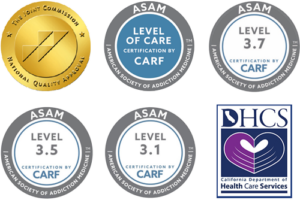Fentanyl Withdrawal Symptoms: Detecting Signs of Opioid Withdrawal
Published on: September 9, 2024 | Updated on: December 12, 2025
Fentanyl, a powerful synthetic opioid, is used medically for severe pain management but has also become a major player in the opioid crisis due to its high potency and potential for abuse. Withdrawal and detox from fentanyl can be intense and challenging, making it crucial to recognize the signs and symptoms to provide appropriate support and intervention.
What is Fentanyl?
Fentanyl is a synthetic opioid analgesic, primarily used for pain management in medical settings. Due to its high potency, it’s often reserved for severe pain that cannot be controlled with other pain medications. It acts on the body’s opioid receptors, producing pain relief, euphoria, and relaxation. However, these effects also make it highly addictive and a substance of abuse.
Forms of Fentanyl
Fentanyl can be administered in several ways, including:
- Transdermal Patches: Slowly release fentanyl over time for chronic pain management.
- Injectable Solutions: Used in hospital settings for immediate pain relief.
- Lozenges or Lollipops: Known as Actiq, used for breakthrough cancer pain.
- Buccal Tablets: Placed in the cheek for rapid absorption.
Fentanyl and additional medications may be prescribed for specific needs and in specific forms to achieve the desired patient care outcome.
Related Opioids
- Fentanyl is part of a broader class of drugs known as opioids. Here are some related opioids:
- Morphine
- One of the most well-known natural opioids.
- Used for severe pain management, particularly in palliative care.
- Heroin
- An illegal opioid derived from morphine.
- Known for its high potential for abuse and addiction.
- Oxycodone
- A semi-synthetic opioid used for moderate to severe pain.
- Common brand names include OxyContin and Percocet (when combined with acetaminophen).
- Hydrocodone
- Used for pain relief and as a cough suppressant.
- Often combined with acetaminophen (e.g., Vicodin).
- Methadone
- Used in pain management and as part of drug addiction detoxification and maintenance programs.
- Buprenorphine
- A partial opioid agonist used for pain and in the treatment of opioid addiction.
- Commonly found in medications like Suboxone (combined with naloxone) and Subutex.
- Under medical supervision, methadone or buprenorphine can be used to break addiction to pain medicines like fentanyl or other opiates.
- Codeine
- A less potent opioid used for mild to moderate pain and as a cough suppressant.
Illicit Use and Synthetic Variants
- Carfentanil:
- An analog of fentanyl that is 100 times more potent than fentanyl and primarily used for large animal tranquilization.
- Extremely dangerous and potent, with a high risk of overdose.
- Alfentanil, Sufentanil, and Remifentanil:
- Synthetic opioids similar to fentanyl, used in medical settings for anesthesia.
- Morphine
How Does Fentanyl Work on the Human Body?
Fentanyl exerts its effects by binding to the body’s opioid receptors, which are part of the endogenous opioid system. This system plays a crucial role in regulating pain, reward, and addictive behaviors. The primary opioid receptors involved in fentanyl’s effects are the mu-opioid receptors (MORs).
Binding to Mu-Opioid Receptors
- Location: Mu-opioid receptors are found throughout the central nervous system (CNS), including the brain and spinal cord, and in the peripheral tissues.
- Activation: When fentanyl binds to these receptors, it triggers a cascade of intracellular events that result in the inhibition of pain signal transmission and the release of neurotransmitters such as dopamine.
Mechanism of Pain Relief
- Pre-Synaptic Inhibition: Fentanyl reduces the release of neurotransmitters like substance P and glutamate from the pre-synaptic neuron. This action decreases the transmission of pain signals to the central nervous system.
- Post-Synaptic Effects: Fentanyl increases the opening of potassium channels and inhibits the opening of calcium channels on post-synaptic neurons. This hyperpolarizes the neuron, making it less likely to transmit pain signals.
Euphoric Effects
- Dopamine Release: Fentanyl’s interaction with mu-opioid receptors in the brain’s reward pathways, particularly in the nucleus accumbens and the ventral tegmental area (VTA), leads to an increased release of dopamine. This surge in dopamine is responsible for the intense euphoria and the addictive potential of fentanyl.
There are numerous other effects, including some that resemble opioid withdrawal syndrome or opioid dependence. These can include dilated pupils, depression of the respiratory system, depression of the gastrointestinal system, sedation, and slurred speech or thoughts.
What is Fentanyl Used For?
Fentanyl is a critical medication in the management of certain pain conditions and anesthesia, offering significant relief to patients with otherwise intractable pain. However, its high potency and risk of abuse necessitate careful management and monitoring in both medical and illicit contexts to prevent misuse and potential fatal outcomes.
Here’s a closer look at the uses, both medical and recreational, to help better understand the basis for severe withdrawal symptoms and the foundation of substance abuse and addiction treatment:
Medical Uses
Fentanyl is a powerful synthetic opioid utilized in various medical settings for its potent analgesic and sedative properties.
- Cancer Pain Management
- Fentanyl is often prescribed for managing persistent pain in cancer patients, particularly when other pain medications are insufficient.
- Post-Surgical Pain Relief
- After major surgeries, fentanyl can be used to alleviate acute pain and improve patient comfort during recovery.
- Anesthesia
- It is commonly used as part of anesthesia protocols during surgeries to ensure pain relief and sedation.
- Chronic Pain Conditions
- Patients with chronic pain conditions, such as those with advanced osteoarthritis or severe nerve pain, may be prescribed fentanyl, especially when other opioids are ineffective.
- Breakthrough Pain
- Fentanyl is used to manage breakthrough pain, which is a sudden and intense flare-up of pain that occurs despite the use of long-acting pain medication.
- End-of-Life Care
- In palliative care settings, fentanyl helps manage pain and improve the quality of life for terminally ill patients.
Recreational Use and Abuse
While fentanyl has legitimate medical uses, its high potency also makes it a target for abuse and recreational drug use too, leading to significant health risks.
- Euphoria and Intense High
- Users seek fentanyl for its ability to produce a powerful sense of euphoria and well-being, which is much stronger than that of other opioids.
- Illicit Drug Market
- Fentanyl is often found on the illicit drug market, sometimes sold as heroin or mixed with other drugs like cocaine and methamphetamine to enhance their effects. This can happen without the user’s knowledge, increasing the risk of overdose.
- Self-Medication
- Some individuals misuse fentanyl to self-medicate for untreated or inadequately managed pain or psychological distress. When individuals treat pain without the assistance of health care providers, risks like overdose and addiction can arise and may lead to clinical manifestations of opioid withdrawal syndrome.
- Tolerance and Dependence
- Due to its potent effects, users quickly develop tolerance, leading to higher doses being needed to achieve the same effects, which significantly increases the risk of dependence and overdose.
- Overdose Risks
- The potency of fentanyl means that even a small amount can lead to respiratory depression and death. This risk is heightened when fentanyl is used in combination with other depressants such as alcohol or benzodiazepines.
How Long Does Fentanyl Stay in Your System?
Because receptors can be found throughout the body and in different bodily fluids, how long certain opioids like fentanyl stay in your system depends on various factors. Some metabolites may pass from the body within several hours. A drug test may be able to detect other metabolites days or even weeks after use of fentanyl, morphine, heroin, or a prescription formula like oxycodone. Hair tests, a urine test, or samples of blood (a blood test) may be used to determine whether a prospective employee has used oxycodone or other drugs recently, potentially putting employment at risk.
To learn more about this topic, visit “How Long Do Opioids Stay in Your System?”
Opioid Addiction: A Growing Epidemic
The opioid epidemic is a widespread and devastating public health crisis characterized by a significant increase in the use of prescription and non-prescription opioid drugs. This epidemic has led to a surge in opioid addiction, overdoses, and deaths across the United States, including the western region states of California, Washington, and others.
The opioid crisis began in the late 1990s when pharmaceutical companies reassured the medical community that patients would not become addicted to opioid pain relievers. This led to widespread prescribing of opioid medications.
The western United States, like the rest of the country, has been significantly affected by the opioid epidemic, with unique regional factors influencing its spread and impact.
Factors Contributing to the Epidemic:
Prescription Practices
- High rates of opioid prescriptions contributed to widespread availability and misuse. States like California, Arizona, and Nevada saw significant prescribing rates during the peak of the crisis.
Economic Stressors
- Areas with economic hardships, particularly in rural and economically disadvantaged communities, saw higher rates of opioid misuse as individuals turned to opioids for relief from physical and emotional pain.
Illicit Drug Trade
- The western United States has major drug trafficking routes, leading to increased availability of illicit opioids such as heroin and fentanyl. Ports of entry along the Mexican border facilitated the smuggling of these drugs into states like California, Arizona, and Nevada.
Urban vs. Rural Divide
- Urban areas experienced higher rates of opioid-related overdoses due to the availability of illicit drugs. However, rural areas faced significant challenges due to limited access to healthcare and addiction treatment services.
Opioid Withdrawal and Its Consequences
Opioid withdrawal can lead to a cascade of negative consequences beyond the immediate physical and psychological symptoms. These broader impacts can significantly affect an individual’s legal standing, social relationships, and financial stability.
Here are some of the key negative consequences of opioid withdrawal:
Legal Consequences
1. Criminal Activity
- Drug-Related Offenses: Individuals struggling with opioid addiction may engage in illegal activities, such as drug possession or distribution, to obtain opioids. Withdrawal can intensify the urge to engage in these activities as cravings increase.
- Theft and Fraud: To support their addiction, some may resort to theft, burglary, or fraud. Withdrawal symptoms can heighten desperation, leading to more frequent or severe criminal behavior.
2. Legal Penalties
- Incarceration: Arrests for drug-related crimes can result in jail or prison time. Withdrawal in a correctional setting can be particularly harsh due to limited access to medical care.
- Legal Fees and Fines: Legal proceedings often involve significant costs, including attorney fees, court fines, and restitution payments.
3. Criminal Record
- Long-term Impact: Having a criminal record can have lasting effects, such as difficulty finding employment, housing, and educational opportunities, further complicating recovery efforts.
Social Consequences
1. Strained Relationships
- Family and Friends: Withdrawal can cause irritability, mood swings, and erratic behavior, straining relationships with loved ones. Trust issues may arise due to past behaviors associated with addiction.
- Isolation: Individuals may withdraw from social interactions due to shame, guilt, or the physical discomfort of withdrawal symptoms, leading to further isolation.
- Employment Issues
- Job Loss: Withdrawal symptoms can affect work performance, leading to absenteeism, reduced productivity, or job loss.
- Difficulty Finding Employment: A history of opioid use and withdrawal can make it challenging to secure new employment due to gaps in work history, criminal records, and ongoing health issues.
2. Healthcare Costs
- Medical Expenses: Managing withdrawal often requires medical intervention, which can be costly. Without insurance or sufficient coverage, individuals may face significant out-of-pocket expenses.
- Rehabilitation Costs: Inpatient and outpatient rehabilitation programs, which are critical for recovery, can be expensive and may not be fully covered by insurance.
Common Fentanyl Withdrawal Symptoms
Opioid withdrawal occurs when a person who is dependent on opioids suddenly reduces or stops their opioid intake. The severity and duration of fentanyl withdrawal symptoms can vary depending on the level of dependence, the type of opioid used, and the duration of opioid use disorder itself.
Common fentanyl withdrawal symptoms include:
1. Physical Symptoms
- Muscle Aches and Pains
- Generalized muscle pain and discomfort are common, making it difficult for individuals to move or rest comfortably.
- Gastrointestinal Distress
- Symptoms such as nausea, vomiting, diarrhea, and abdominal cramps can lead to dehydration and electrolyte imbalances. Opiate withdrawal has the potential to lead to severe dehydration, often leading to complications in both physical and mental health.
- Sweating and Chills
- Excessive sweating and episodes of chills and goosebumps are typical during opioid withdrawal, causing physical discomfort.
- Restlessness and Insomnia
- Difficulty sleeping and a sense of restlessness can persist, exacerbating fatigue and irritability.
- Runny Nose and Watery Eyes
- These symptoms are similar to those of a common cold and can be bothersome.
- Elevated Heart Rate and Blood Pressure
- Increased heart rate and high blood pressure can occur, potentially leading to cardiovascular strain.
2. Psychological Symptoms
- Anxiety and Agitation
- Individuals often experience heightened anxiety and feelings of nervousness or agitation.
- Depression and Mood Swings
- Depressive symptoms and sudden mood changes can occur, leading to feelings of hopelessness and emotional instability.
- Cravings
- Intense cravings for opioids can drive individuals to relapse in an attempt to alleviate withdrawal symptoms.
3. Cognitive and Behavioral Symptoms
- Difficulty Concentrating
- Cognitive functions such as concentration and memory can be impaired during withdrawal.
- Impaired Judgment
- The combination of physical and psychological distress can lead to poor decision-making and risky behaviors. Just like alcohol dependence, drug abuse patients may make poor decisions with devastating consequences.
- Over time and use, mental disorders can potentially lead to negative consequences, costing an opioid addict his or her freedom or causing life threatening injury or severe opiate withdrawal.
There’s Help for Opioid Dependent Patients
Treating opioid addiction requires a comprehensive approach that addresses the physical, psychological, and social aspects of the disorder. Here are the primary treatment options available for individuals struggling with opioid addiction, including fentanyl withdrawal management practices:
Medication-Assisted Treatment (MAT)
1. Methadone
- How it Works: Methadone is a long-acting opioid agonist that reduces cravings and opioid withdrawal symptoms by activating opioid receptors in the brain without producing the euphoric high associated with other opioids.
- Administration: Typically administered daily under supervision at a specialized clinic.
- Benefits: Helps stabilize patients for withdrawal management, allowing them to focus on counseling and behavioral therapies.
2. Buprenorphine
- How it Works: Buprenorphine is a partial opioid agonist that activates opioid receptors to a lesser degree than full agonists like heroin or methadone, reducing cravings and withdrawal symptoms.
- Administration: Available in various forms, including tablets, films, and extended-release injections. It can be prescribed by certified physicians, allowing for more flexible treatment settings.
- Combination with Naloxone: Often combined with naloxone (as in Suboxone) to deter substance abuse syndrome or misuse.
3. Naltrexone
- How it Works: Naltrexone is an opioid antagonist that blocks opioid receptors, preventing the euphoric effects of opioids. It is used after detoxification to help maintain abstinence.
- Administration: Available as an oral tablet or a monthly injection (Vivitrol).
- Benefits: Reduces the risk of relapse by eliminating the rewarding effects of opioids.
Behavioral Therapies
1. Cognitive-Behavioral Therapy (CBT)
- Focus: Helps individuals recognize and change negative thought patterns and behaviors associated with opioid use.
- Techniques: Includes coping strategies, problem-solving skills, and relapse prevention. Mental health services are critical in withdrawal management and for long-term substance abuse and addiction treatment.
2. Contingency Management
- Focus: Uses positive reinforcement to encourage sobriety and healthy behaviors.
- Techniques: Provides rewards or incentives for meeting treatment goals, such as maintaining abstinence or attending therapy sessions.
Commit to Treatment. Keep Your Job!

Connect with Journey Hillside Tarzana Today
Whether you are struggling with opioid addiction or other drug abuse disorders, Journey Hillside Tarzana offers a wide range of custom-tailored drug and alcohol detox services. From medically supervised opioid withdrawal to residential treatment options, medication assisted treatment, and more, the healthcare professionals at Journey Hillside uses industry best practices in a calming, restorative, and supportive environment. Reach out to our Admissions Team today to learn more about individualized recovery plans at our treatment center.





